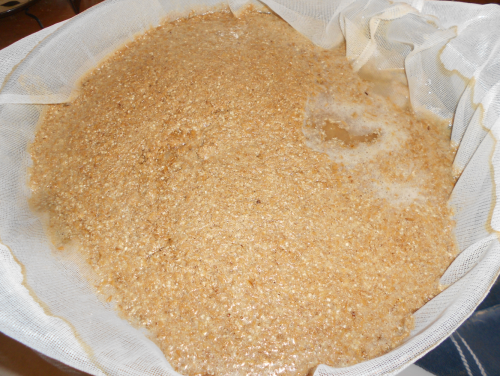Gluten Free Home Brewing Blog
Brew In A Bag: Rice Malt Grain Absorption Rate Revealed
Updated 11.6.17!
Today, BIAB batch number 5 went into the kettle, and we feel optimistically back on track. Batches number 3 and 4 were dumped down the drain after very low conversion. We compared our brewing journal notes for each batch to what we know about brewing gluten free beer. Some things started to take shape. We suspected the thin mashes of the batches number 3 and 4 may have diluted the enzymes to the point there was little conversion. In our all-grain brewing the quarts/pounds ratio is 1:1. As we increased the water volume to account for grain absorption, that ratio went to about 3:1. Although we have read that a thin mash could actually increase conversion in conventional brewing, we don't think a 3:1 ratio was what those articles would consider thin! And then there is the very real probability what works in conventional brewing doesn't work when brewing gluten free.
A few variables before we continue. BIAB brewing does a terrible job filtering the wort as there is no sparge and lautering process. We measured our kettle trub from our last batch and calculated for 1/2 gallon in our 2 gallon batch. We also assumed a 1.25 gallon an hour boil off rate, which is consistent with our first four batches. So for our 2 gallon batch we used a 10 LB grain bill and started with 5.75 gallons of strike water at 172F to get a 3.75 gallon preboil volume. We did not "squeeze the bag" after the mash, but we did let it drain sufficiently and achieved a little over our target of 3.75 gallons. That makes the grain absorption rate of rice malt 20%, or thereabouts!
Eckert Malting & Brewing Co is currently dehulling three varieties of malt for us to experiment with, and agreed to weigh the separated rice hulls for us. This will tell us the percentage of rice malt that is actually just the hull. We can then confirm our calculations for grain absorption rate of rice malt before we move onto millet and buckwheat. Spoiler alert....we are also considering carrying dehulled Pale Rice Malt in the future!

(Grain bill on top of false bottom to create artificial thick mash)
Let's get to the next important variable, our conversion. Our quarts/pounds ratio to derive at the correct grain absorption rate was a whopping 2.3:1! We did not want another thin mash after little conversion from our last two batches. We put the false bottom back in the kettle to artificially create a thicker mash. We also bumped up the amylase enzymes to the same ratio of the quarts/pounds, and pitched 23 ml of AMG-300L. After 90 minutes we removed the false bottom, stirred the grain bill just enough to break it up, pitched another 10 ml of AMG-300L, and let that rest another 30 minutes. The mash temperature dropped by 10F to about 153F. Our thought process was to give the b-amylase an opportunity to work in a more ideal and lower temperature, and in a thinner mash which if memory serves me correctly, is favorable to the b-amylase. (I need to fact check that one later!).

(Grain bill after false bottom was removed)
The verdict? 1.045 O.G. This is pretty terrible but we think it confirms our theory about how thick or thin the mash needs to be. The first two batches had an O.G. of 1.056 and 1.050, and were thicker mashes. Starting at the BIAB calculator default setting of 4.5% grain absorption rate (and default trub and boil off rates) we had O.G.'s of 1.056, 1.050 1.03?, 1.027 and then back up to 1.045. Although other variables did vary from mash to mash, the most significant change was adjusting the total water volume to compensate for grain absorption.
We are not giving up on the BIAB method yet because it seems like a great way to make small 1 and 2 gallon batches for experimentation, recipe development, or when 5 gallons is just too much beer to drink. But, we think it needs to be modified to a 1:1 quarts/pounds ratio and include a sparge to get to the preboil volume, and get the most out of the grain bill. Our next recipe is on paper and we will be brewing again next weekend.
11.6.17 Update: Eckert Malting & Brewing Co dehulled a few bags of rice malt for us and calculated the grain to hull ratio. Rice malt contains approximately 62.5% grain to 37.5% hull. This ratio certainly explains why it is impossible to get a stuck mash using rice malt. We assume this attributes to the high grain absorption rate of rice malt. Our tutorials recommend using 20-25% rice hulls with the grain bill to ensure appropriate circulation and filtration. However, depending on when we developed our individual recipe kits, the percentage of rice hulls may be as little as 10%. We are not intentionally trying to create confusion. Much of what we have learned about brewing gluten free beer has been acquired since we started as a facebook page in 2010! Until now, the grain absorption rate of rice malt and ratio of grain to hull of rice malt has been unknown. Going forward we can all use this information to design much more precise recipes.
Cheers!